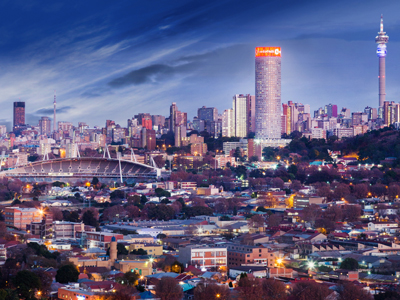The impetus to Johannesburg’s growth came from an industry with a highly disturbing death rate.
South African gold mining really got its start with an 1886 discovery and subsequent rush at Langlaagte, then an isolated farm. Already the world’s largest diamond producer, the country went on to become the behemoth of global gold reserves until 2007. But all that wealth left a damning legacy in an extensive network of abandoned tunnels that lure illegal and desperate gold hunters, often to their deaths. A cave-in and several fatalities in mid-September brought Langlaagte back to international prominence. It’s just one of many such stories playing out in South Africa.
The rising death toll shows the problem’s “spiralling out of control,” Bloomberg quoted Christo de Klerk. Addressing a Johannesburg news conference on September 27, the CEO of Mines Rescue Services said his highly trained volunteer group had recovered 24 bodies so far this year, the largest number in seven years of records.
Even this year’s total marks “the tip of the iceberg,” he stressed. Maybe 90% of the casualties never get reported, which would mean hundreds of missing people have died in their graves.
Speaking with Warren Dick of MineWeb.com, de Klerk explained that many of the mines have been abandoned for 60 to 70 years, lacking maps or plans. Without ventilation, gas build-ups can occur. Moreover the diggers often target the pillars, increasing their instability and exacerbating an already dangerous enterprise.
It’s no way to live and a horrible way to die, as shown by some very disturbing photos released by de Klerk’s organization.
This is the world of the zama-zamas, people who might live underground for months at a time. Often working in gangs, they haul in explosives, generators and stockpiles of food, de Klerk told Bloomberg.
Deprived of sunlight for so long, “their skin turns grey,” Matthew Hart wrote in his 2013 book Gold: The Race for the World’s Most Seductive Metal. “The wives and prostitutes who live with them turn grey. In South Africa they call them ghost miners. They inhabit an underground metropolis that in some goldfields can extend for 40 miles, a suffocating labyrinth in which the only glitter is the dream of gold.”
Gang warfare delivers additional menace. De Klerk said most of the illegal miners come from Mozambique, Zimbabwe and Lesotho, whose factions fight underground turf wars. His rescuers have encountered murder victims, in one case a grisly pile of 10 bodies that had been shot execution style, he told MineWeb.com.
The deadly business puts conflict gold on the market. A spokesperson for the SA police elite Hawks unit told Hart that organized crime sends the illicit gold to the Persian Gulf, India and Russia, where it’s laundered into the legitimate bullion trade. “Big players” in police and government support the trade, he said. A 2001 industry study by Peter Gastrow “reached the same conclusion: that an untouchable elite was behind the theft of gold,” Hart wrote.
While rogue miners are said to be predominantly immigrants, they include some South Africans, even legitimate mine employees looking for extra income. In February Sibanye Gold NYSE:SBGL reported two contractors became trapped after entering an abandoned part of the company’s Cooke mine at the end of their shift.
That same day Sibanye reported a fatality in one of its own operations. The SA industry remains deadly, legal or illegal. Harmony Gold Mining NYSE:HMY, for example, reported six separate fatalities so far this year, nearly reaching last year’s total of seven.
In the first eight months of this year 61 people died in South African mines, according to Department of Mineral Resources numbers reported by MiningWeekly.com. Last year’s 12-month total came to 77, according to the industry’s Chamber of Mines.
But in February the Mail and Guardian stated the number of accidents, fatal or not, had risen by 500 in the 12 months prior to February. “In the past five years, there have been at least eight accidents a day in mines, injuring more than 15,000 people,” wrote Athandiwe Saba.
That’s not counting occupational diseases. Earlier this month acting chief mines inspector Xolile Mbonambi told an industry conference that 6,577 cases of mining-related diseases were recorded in 2014, MiningWeekly.com reported. Interim figures for 2015 show a slight improvement in the number of silicosis cases but an increase in TB, which Mbonambi called “an indictment on the industry broadly.”
“Moreover, he highlighted that the repercussions of fatalities extended well beyond the boundaries of mines and had substantial socio-economic impacts, affecting the poorest of the poor locally and communities of neighbouring countries the most,” MiningWeekly.com added.
As for the violence, it doesn’t end with gang rivalries. Rival unions have been killing each other’s members at the rate of several murders a year. Meanwhile the newcomer Association of Mineworkers and Construction Union gains members at the expense of the National Union of Mineworkers. Some observers attribute the NUM slide to a lack of confidence following Marikana, where in a single burst of gunfire police killed 34 striking platinum miners in 2012.
If there’s truth to the accusations, South African mining might harbour yet another threat. After Sikhosiphi Bazooka Radebe was gunned down in front of his family last March, some people attributed the murder to his work as an anti-mining activist.
September 16 marked the 30th anniversary of the country’s Kinross disaster, which killed 177 miners.
Source: http://resourceclips.com/2016/09/30/cry-the-resource-rich-country/

